
Predicate
All discussions of research papers on nitrate must be predicated with a caution. The 10 ppm of nitrate (NO3-N) of the scientists, (the Hach test kit and the Lamotte test kit) is a 44 ppm test level of nitrate (NO3) via the “normal” aquarium test kits (API aquarium test kit, the Seachem Multitest kit, the Sera Nitrate test, the Salifert test kit and the API test strips). So most of the scientific studies need the limits to be multiplied by 4.4 to come up with proper “nitrate” levels for the hobbyist.
This is because scientists look at ONLY the nitrogen in the nitrate, they do not look at the oxygen in the nitrate (nitrate is one nitrogen atom and three oxygen atoms). The API and other aquarium tests look at the entire nitrate; nitrogen AND oxygen. Note that the chemistry of the tests is identical. It is only the number assigned to each color which changes. For instance, with the API test orange is 40 ppm (NO3), with the Hach Test (NO3-N) orange is 8 ppm.
This is a very long and complex article only for the real nerds, like the author. Read on only if you want to be put to sleep.

Summary
Those who say that tropical fish have poor health if kept in water over 20 ppm of nitrate are being far too cautious. There is no evidence that anything lower than 80 ppm nitrate per the API test even AFFECTS fish. There is evidence levels down to 40 ppm can AFFECT shrimp and axotyl. Note that the obvious problem is that AFFECT and HARM are not synonyms.
Nitrate is not very toxic to higher animals which have well developed livers, like fish. The reason is simple. The liver is an amazing chemical factory. In the liver nitrate is converted to ammonium (NH4). This ammonium in humans is converted to urea and excreted through the kidneys. In fish the ammonium is excreted directly out the gills as ammonia gas. Thus adult fish and adult humans handle nitrate quite well and it has a low toxicity for both.
And algae do NOT “thrive at high nitrates” in a planted aquarium. Indeed, the estimative index method of fertilizing uses very high levels of nitrate to control algae by encouraging vascular plant growth. Rapid vascular plant growth is the best way to control algae.
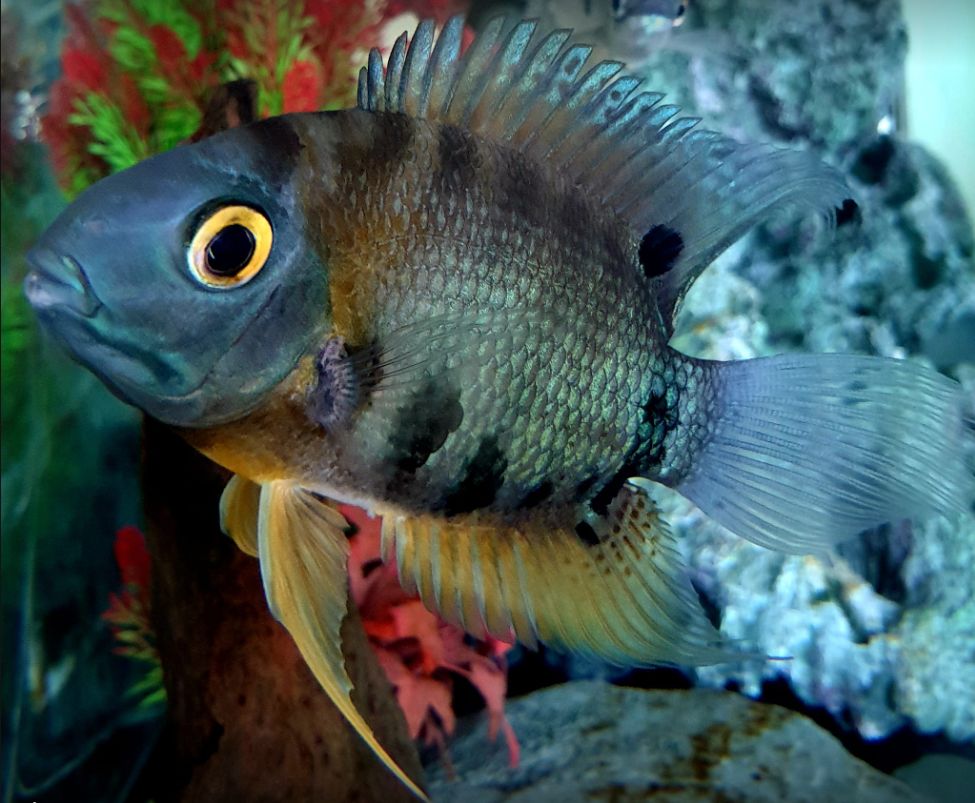
Research Papers
The first number to consider when looking at nitrates and fish is the “lethal toxicity”. This is the concentration where 50% of the fish died in a certain period, or the LC50. This is something along the lines of 72-h lc50 mg 1−1 −N. This is the concentration (expressed in parts per million of nitrate NITROGEN ONLY) where 50% of the fish died in 72 hours or 72 hour LC50 in mg/L (ppms) of Nitrogen in Nitrate. This number always must be multiplied by 4.4 to get the number the API test kit gives.
If one puts all the papers together and looks at the LC50 per the API test hobbyists use, one gets the following chart:
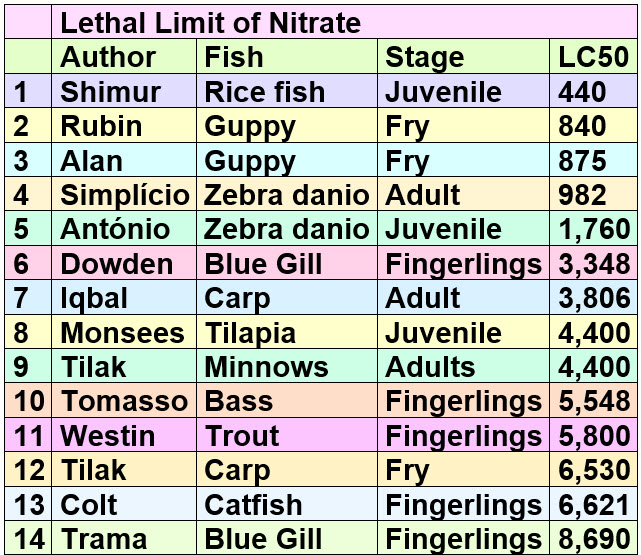
It is apparent that the first five fish, which are the only aquarium fish in the list, have lower numbers than the other fish. But the average of these five aquarium values is still 979 ppm nitrate. This is VERY high. And obviously the other data is HUGE. Nitrate is simply not very toxic to fish.
I did get into a back-and-forth with one … well … damn …. I’m not supposed to say that word ….. “interesting individual” who had done a “thorough review of the literature” and somehow come to the conclusion that the rice fish study is the ONLY study applicable to aquariums. AND they ignored that the study’s 100 ppm nitrate is actually 440 per the API test. This individual came up on social media and said that “scientific research studies show any nitrate over 100 ppm is toxic to aquarium fish“. What is really frustrating is that they maintained this belief even after the data here-in is presented to them.
There are FIVE papers which used aquarium fish which averaged 979 ppm nitrate And one cannot completely ignore all the other studies.
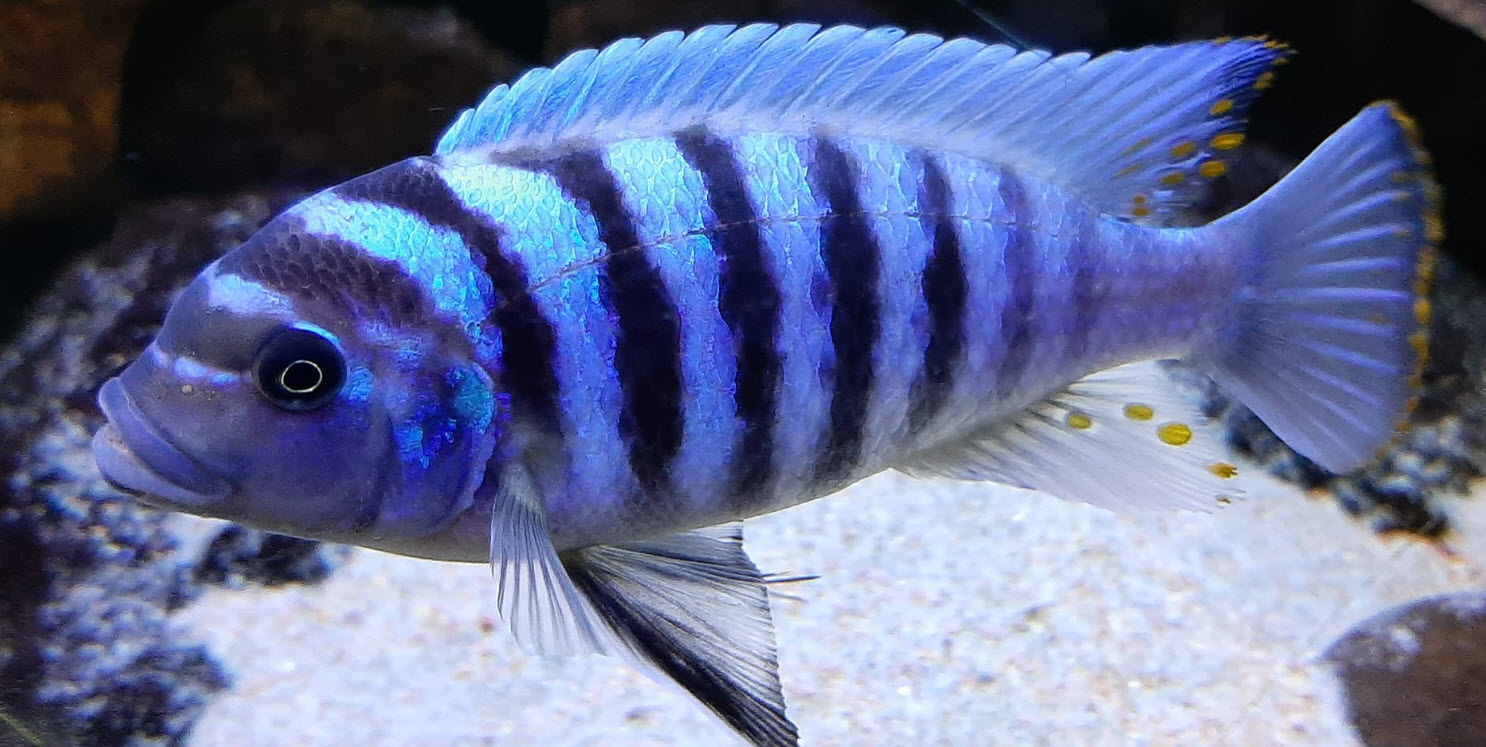
Each Paper
Per one paper: “Recirculating Aquaculture Tank Production Systems”, Masser et. al. Southern Regional Aquaculture Center, March 1992:
“Nitrate, the end product of nitrification, is relatively nontoxic except at very high concentrations (over 300 ppm)”.
Considering that this article uses nitrate nitrogen, which means the aquarium owners API test kit has to hit 300 x 4.4. or 1,320 ppm nitrate in order for nitrate to be toxic per this authority.

To illustrate the low toxicity of nitrate, a research paper is pertinent (“Studies on the Toxicity of Ammonia, Nitrate and Their Mixtures to Guppy Fry”, Alan et al, 1977):
“Using guppy fry as the test fish the individual and joint toxicities of ammonia and nitrate were estimated in static tests at constant pH and temperature. The 72-h lc50 values were 199 and 1.26 mg 1−1 −N for potassium nitrate and free ammonia, respectively. The toxicities of mixtures of the two were additive except at very low ammonia to nitrate ratios.”
This takes some interpretation. The term “mg 1-1 -N” is milligrams per liter of nitrate nitrogen (the N in NO3). This is what researchers use. Milligrams per liter is the same as parts per million (ppm). This is because a milligram is one one thousandths of a gram and there are one thousand grams in a liter.
To convert the nitrate nitrogen to what fishkeepers use as nitrate (total nitrate, i.e. both the nitrogen and the oxygen in NO3) one must multiply the researchers’ number by 4.4. Thus at 72 hours 50% of the guppy fry were dead when presented with 875 ppm of nitrate. That is a very low toxicity, especially considering this was for fry.
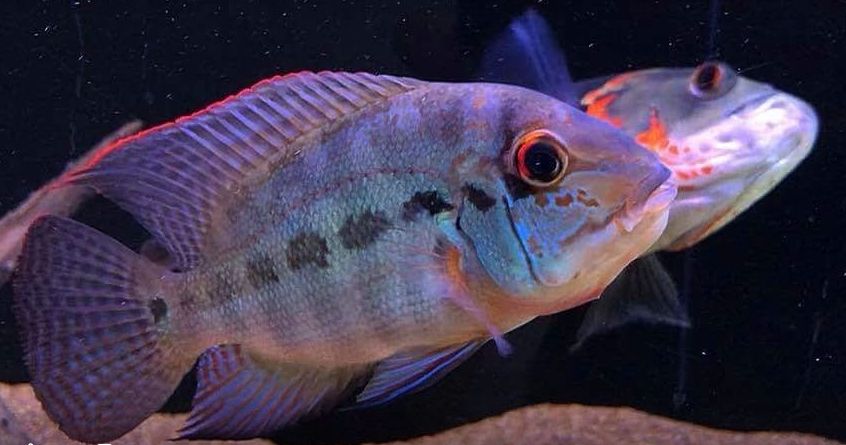
There is one paper which pretty much sums ups the effect of nitrate on fish (“Histopathological Changes in the Liver of a Farmed Cyprinid Fish, Cyprinus carpio, Following Exposure to Nitrate”, Iqbal et. al, 2005):
“LC50 of nitrate to Cyprinus carpio, according to Reed-Muench method, were 995 ppm for 48-hr and 865 ppm for 96-hr.”
So the levels of toxicity and death for these carp in this test were 865 x 4.4 or 3,806 ppm of nitrate with the API test kit.
Another study (“Comparative Analysis between Ecotoxicity of Nitrogen, Phosphorus, and Potassium-Based Fertilizers and Their Active Ingredients” Simplício et al, 2017) found the four-day lethal concentration of nitrate per the API test with zebra danio to be 982 ppm to 1226 ppm at a pH of 7.2. This is very low toxicity again and is probably more applicable to aquariums with adult fish in them.
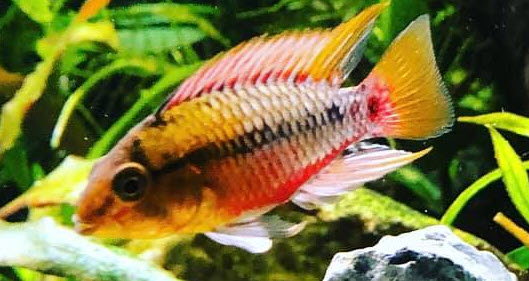
Many claim that levels over 10 ppm of nitrate create chronic long term damage to the fish. The literature does not support this claim; “Histopathological Changes and Zootechnical Performance in Juvenile Zebrafish (Danio rerio) Under Chronic Exposure to Nitrate”, António et. al.
2017:
This study evaluated the impact of chronic exposure to relevant levels of nitrate on the zootechnical performance and histology of selected organs (gills, integument, kidney, liver, and intestine) of juvenile zebrafish, with the aim to define safety levels of this nitrogenous compound for zebrafish rearing. For that, groups of 30-day-old zebrafish were exposed to < 7 (control), 100, 200, and 400 mg L− 1 nitrate-N for 28 days.
No mortality was registered in fish exposed up to 200 mg L− 1 nitrate, and all individuals seemed externally healthy; however, in fish exposed to the highest nitrate concentration mortality reached 47% at the end of the trial, and many individuals showed lethargy, abnormal swimming, emaciation, lordosis, and/or superficial lesions. Although final growth was not significantly different among groups, growth parameters tend to decrease with increasing levels of nitrate, and a significant negative correlation was found between weight gain and nitrate levels, suggesting a dose-dependent negative effect of nitrate on growth.
Except for the lowest nitrate concentration (100 mg L− 1 nitrate-N), the histological survey revealed significant changes induced by nitrate in all examined organs, and a dose-dependent effect of nitrate on the overall histopathological changes is suggested. In conclusion, this study shows that the chronic exposure of zebrafish juveniles to nitrate induces histopathological changes that would lead to a negative impact on the general health condition of fish. Fish growth tended to decrease and the overall histological damages tended to increase with increasing nitrate levels, particularly above 100 mg L− 1 (the lowest tested value). Thus, we recommend that this limit of 100 mg L− 1 nitrate-N should not be exceeded in RAS during rearing of juvenile zebrafish.
Again, this takes some interpretation. 100 mg L− 1 nitrate-N is 440 ppm of nitrate for a long-term chronic toxicity. This is very high, and it applies to juveniles, which are generally much more sensitive to toxins than adult fish.
These last three studies are also important in that they were run on guppies and zebra danio, tropical aquarium fish. They were not run on some fish bred to be mass produced for food in large aquaculture farms. So the data from these three studies is quite applicable to freshwater tropical aquariums.
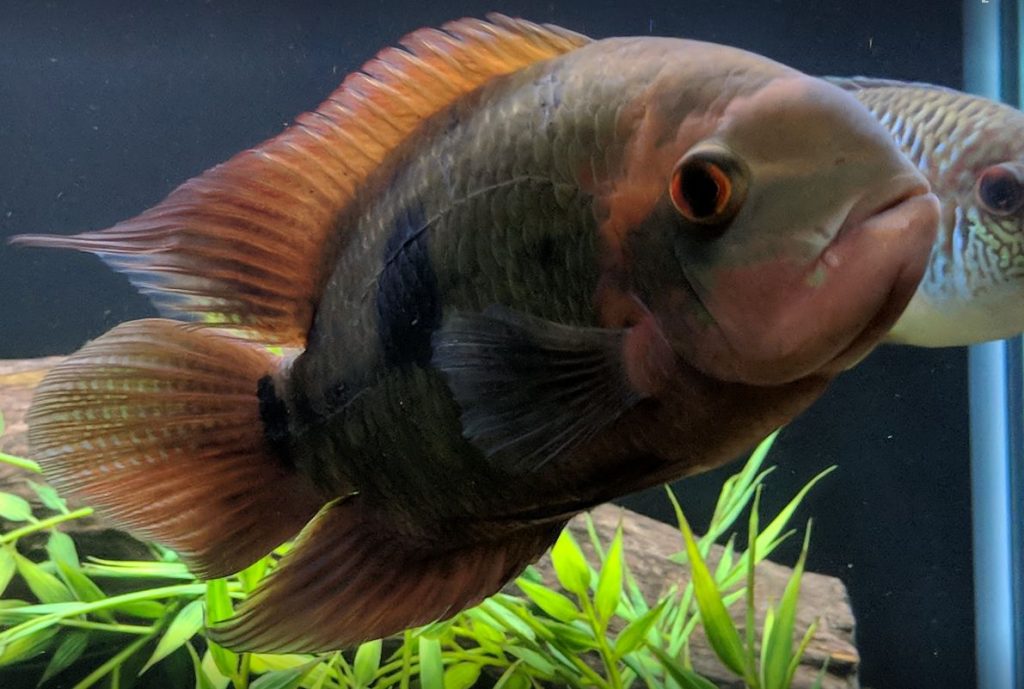
Tilapia are even higher in their resistance to the effects of nitrate. “Chronic Exposure to Nitrate Significantly Reduces Growth and Affects the Health Status of Juvenile Nile Tilapia (Oreochromis niloticus L.) in Recirculating Aquaculture Systems”, Monsees et. al., 2016:
“In our study, Nile tilapia (Oreochromis niloticus) were exposed to five different nitrate concentrations (0, 10, 100, 500 and 1000 mg L−1‐N) over 30 days. Growth parameters (feed conversion ratio (FCR), specific growth rate (SGR), hepatosomatic index (HSI)), blood samples) and the histology of the gills were studied to evaluate growth and health status of the fish. At the highest nitrate concentration, the fish showed significantly reduced growth and impaired health status (haemoglobin and methaemoglobin concentration), demonstrating that too high nitrate concentrations can negatively influence tilapia production in RAS. Here, we recommend not exceeding concentrations of 500 mg L−1 ‐N in juvenile tilapia culture to ensure an optimal health and growth status of the fish, as below that concentration no effects on the tilapia have been observed.”
This study again uses the research standard of nitrate nitrogen (the N in the NO3) rather than the aquarium standard of nitrate (NO3). So the numbers have to be multiplied by 4.44. This gives an astonishing level of 2,220 ppm of nitrate as the long-term lower limit for tilapia.

Another very pertinent study evaluated the long term effect of nitrate on juvenile Atlantic Salmon. “Evaluating the chronic effects of nitrate on the health and performance of post-smolt Atlantic salmon Salmo salar in freshwater recirculation aquaculture systems”, Davidson et al, 2017:
“Commercial production of Atlantic salmon smolts, post-smolts, and market-size fish using land-based recirculation aquaculture systems (RAS) is expanding. RAS generally provide a nutrient-rich environment in which nitrate accumulates as an end-product of nitrification. An 8-month study was conducted to compare the long-term effects of “high” (99 ± 1 mg/L NO3-N) versus “low” nitrate-nitrogen (10.0 ± 0.3 mg/L NO3-N) on the health and performance of post-smolt Atlantic salmon cultured in replicate freshwater RAS. Equal numbers of salmon with an initial mean weight of 102 ± 1 g were stocked into six 9.5 m3 RAS. Three RAS were maintained with high NO3-N via continuous dosing of sodium nitrate and three RAS were maintained with low NO3-N resulting solely from nitrification. An average daily water exchange rate equivalent to 60% of the system volume limited the accumulation of water quality parameters other than nitrate. Atlantic salmon performance metrics (e.g. weight, length, condition factor, thermal growth coefficient, and feed conversion ratio) were not affected by 100 mg/L NO3-N and cumulative survival was >99% for both treatments. No important differences were noted between treatments for whole blood gas, plasma chemistry, tissue histopathology, or fin quality parameters suggesting that fish health was unaffected by nitrate concentration. Abnormal swimming behaviors indicative of stress or reduced welfare were not observed. This research suggests that nitrate-nitrogen concentrations ≤ 100 mg/L do not affect post-smolt Atlantic salmon health or performance under the described conditions.”
Again, using the 4.44 conversion factor for nitrate in the aquarium’s tests, this says 440 ppm of nitrate had NO EFFECT at all on salmon fry at the eight month point. This is a relatively long term and is very telling, especially since it was with a known sensitive species and it was done with fry, not adults.
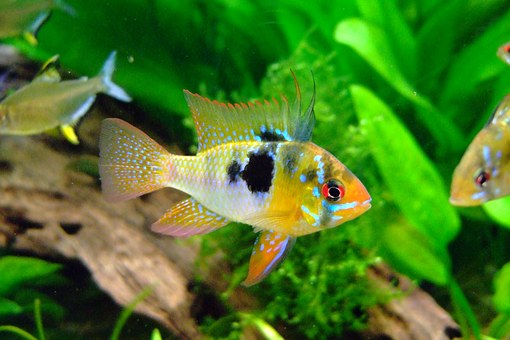
Another study looked at nitrate effect on rainbow trout: “Comparing the effects of high vs. low nitrate on the health, performance, and welfare of juvenile rainbow trout Oncorhynchus mykiss within water recirculating aquaculture systems”, Davidson et. al. 2014
Previous research indicates that rainbow trout Oncorhynchus mykiss begin to exhibit health and welfare problems when cultured within water recirculating aquaculture systems (WRAS) operated at low exchange (6.7 days hydraulic retention time) and a mean feed loading rate of 4.1 kg feed/m3 daily makeup flow. These studies could not conclusively determine the causative agent of the health and welfare issues, but accumulation of mean nitrate nitrogen (NO3-N) to approximately 100 mg/L was determined to be a potential cause of abnormal swimming behaviors such as “side swimming” and rapid swimming velocity. A subsequent controlled, 3-month study was conducted to determine if NO3-N concentrations of 80–100 mg/L resulted in chronic health issues for rainbow trout. Equal numbers of rainbow trout (16.4 ± 0.3 g) were stocked within six replicated 9.5 m3 WRAS. Three WRAS were maintained with a mean NO3-N concentration of 30 mg/L (“low”) resulting from nitrification, and three WRAS were maintained with a mean concentration of 91 mg/L (“high”) via continuous dosing of a sodium nitrate stock solution in addition to nitrification. All six WRAS were operated with equal water exchange (1.3 days mean hydraulic retention time) and mean feed loading rates (0.72 kg feed/m3 daily makeup flow), which provided enough flushing to limit the accumulation of other water quality concentrations. Rainbow trout growth was not significantly impacted by the high NO3-N treatment. Cumulative survival for fish cultured within the high NO3-N WRAS was lower and bordered statistical significance, which resulted in total rainbow trout biomass that was significantly lower for this group at study’s end. In addition, a significantly greater prevalence of side swimming rainbow trout occurred in the high NO3-N treatment, as was observed during previous research. Swimming speeds were generally greater for rainbow trout cultured in the high NO3-N treatment, but were not always significantly different. Although most water quality variables were controlled, significant differences between treatments for the concentrations of other water quality parameters inhibited definitive conclusions regarding the effect of NO3-N. However, due to the unlikely toxicity of confounding water quality parameters, study results provided strong evidence that relatively low NO3-N levels, 80–100 mg/L, were related to chronic health and welfare impacts to juvenile rainbow trout under the described conditions.”
This study says there was “strong evidence” which was not “statistically significant” that 440 ppm nitrate per the API test had a negative effect on juvenile trout over a three month period. But trout are a known sensitive species and the test was done on juveniles, which are more sensitive than adults.
And the author is an experienced statistician. No responsible scientist should ever say there was “strong evidence” which was not “statistically significant”. If it is not “statistically significant” it is not “evidence” in science, period. This makes the whole paper very questionable, as there was obvious “experimental bias”. But even with that caveat, 80 to 100 converts to 352 to 440 ppm nitrate per the API test.

Yet another study looked at freshwater minnows: “Effects of ammonia, nitrite and nitrate on hemoglobin content and oxygen consumption of freshwater fish, Cyprinus carpio (Linnaeus)”, Tilak et. al., 2007,
“Lethal effects of nitrogenous compounds ammonia, nitrite and nitrate on freshwater fish Cyprinus carpio were studied and the static LC50 values obtained for these 3 toxicants for 24 hr were 0.80 ppb, 171.36 ppm; 1075.10 ppm and continuous flowthrough LC50 values for 24 hr were 0.72 ppb, 154.31 ppm; 967.63 ppm respectively.”
This study on minnow was only for 24 hours but fifty percent of the fish died at nitrate level of about 4,400 ppm (1075.10 x 4.4 and 967.63 x 4.4) per the API nitrate test. This was very high.

This study on minnows was then used on a Reddit Aquarium forum as the basis for extrapolating the long-term effects of nitrate on fish using one well established toxicity model, the Reduced Life Expectancy (RLE) model. The RLE model uses something called negative logarithmic algebra.
This research was done and reported on in one aquarium Reddit forum by unknown authors. The author(s?) seemed to know very well what they were doing in their research and in all the graphs and charts they used. Based on the model they came up with the following reduced life expectancies, which for some reason is in error.
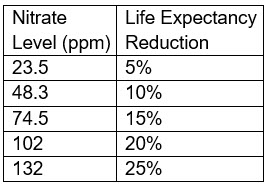

The author of this website has some experience in what are called logarithmic math since he has done many fatigue studies on structures which require doing logarithmic math. When he applied the formulas for the Reduced Life Expectancy (RLE) model to the minnow study the data came out completely and utterly different:
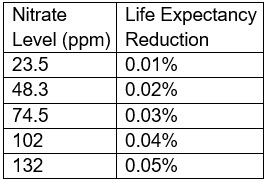
This is a difference of a factor of 500 in the figures. It appears the author(s) of the Reddit article may have used a positive logarithmic graph and math. The RLE model requires a negative logarithmic graph and math. This error is just very confusing since the author(s) of the Reddit article seemed to be truly knowledgeable. But so be it!
The correct chart show very little effect on life expectancy up to 132 ppm NO3 nitrate on the minnow. Go figure????

Studies with Questionable Conclusions
When talking about the factors such as nitrate in the environment one has to be cautious. Politics becomes important. There are a host of “return to loincloth” researchers out there whose obvious goal is to “prove” any pollution of the water by ANYTHING is horrible and has to be avoided at all costs.
There are thus several studies where there is some rather obvious “experimental bias”. “Experimental bias” is the enemy of good research.
One review (“Nitrate Toxicity to Aquatic Animals: a Review with New Data for Freshwater Invertebrates”, Camargo et. al. 2004,) found the lowest “SENSITIVITY” levels of nitrate to very sensitive animals:
“Published data on nitrate toxicity to freshwater and marine animals are reviewed. A nitrate concentration of 10 mg NO3-N/l (USA federal maximum level for drinking water) can adversely affect, at least during long-term exposures, freshwater invertebrates (E. toletanus, E. echinosetosus, Cheumatopsyche pettiti, Hydropsyche occidentalis), fishes’ eggs and larvae (Oncorhynchus mykiss, Oncorhynchus tshawytscha, Salmo clarki), and amphibians (Pseudacris triseriata, Rana pipiens, Rana temporaria, Bufo bufo). Safe levels below this nitrate concentration are recommended to protect sensitive freshwater animals from nitrate pollution.”
This is a very misleading conclusion by the authors. The 10 ppm (44 ppm via the API nitrate test) is in terms of LOEC (lowest observed effect concentration), NOEC (no observed effect concentration) or NOAEL (no observed adverse effect level) on only fish eggs and fry. In other words there might be something like some change in the pathology or the behavior of the of eggs or fry at the 44 ppm level.
Just think about those measurement: LOWEST OBSERVED EFFECT. Simply because the fish are doing something different could just be due to the increased salts in the water and have nothing to do with the nitrate (the controls invariably had no salt at all added, a defect in the experiment one can drive a Mack truck through). And simply because a fish moves in a different way in no way proves that there has been any harm to the fish. An “EFFECT” is not synonymous with “HARM“.
This research says very low levels of nitrate are “recommended to protect sensitive freshwater animals from nitrate pollution”. Because “effect” is not synonymous with “harmful”, this conclusion is decidedly unwarranted.
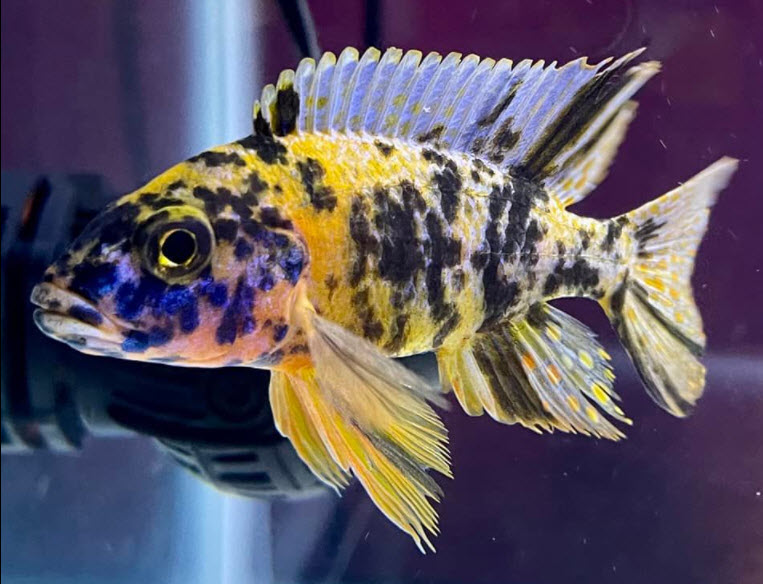
Here is the complete chart from Carmargo:

The lowest toxicity levels observed were an LC50 level of 191 N-NO3 or 840 ppm per the API nitrate test kit for guppy fry (Rubin and Elmaraghy, 1977).
This chart shows that the fry of the fathead minnow (Pimephales promelus) had an NOEC (no observed effect concentration) 7d of 1,575 NO3 nitrate level. In other words after seven days at 1,575 NO3 nitrate there was NO effect at all on the minnow FRY. The LOEC (lowest observed effect concentration) 7d was 3,155 NO3 Nitrate.
These levels are very high. Something which the authors of this article conveniently seem to ignore. There was only ONE reference here where there was a notable EFFECT on fish fry at low nitrate concentrations (Kincheloe et. al. 1979). This is hardly enough evidence for any conclusion to be made, especially given the politics involved. So this study does NOT support low nitrate level requirements.
Indeed, this study supports HIGH nitrate levels. The average of the sixteen freshwater LC50 values is an astounding 4,918 ppm of nitrate (1,117 nitrate nitrogen). The conclusions of this study appears to be a product of the politics involved.
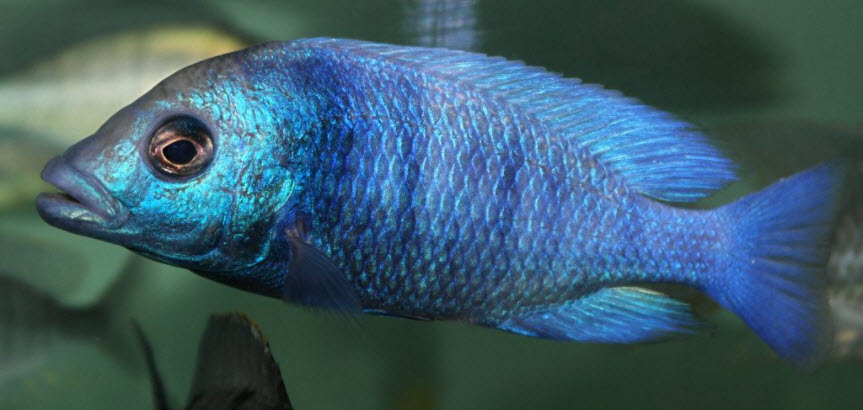
Cautions About NOEL Nitrate Studies
Sometimes one sees articles by scientists with rather obvious biases toward “protection of the environment from any human contamination at any and all cost”. Two such reports are a British Columbia paper “Water Quality Guidelines for Nitrogen (Nitrate, Nitrite, and Ammonia) Overview Report Update” Nordin, et. al. 2009. and a New Zealand paper “A Review of Nitrate Toxicity to Freshwater Aquatic Species”, Hickey et. al. 2009.
Both papers base much of their data on “NOEL” studies. “NOEL” is an acronym for “No Observed Effect Limit”. In other words, the fish changed something in their behavior or pathology at a certain concentration of something like potassium nitrate at a 95% confidence level in the statistics. As we discussed above, this is NOT a good way to create limits on an environmental pollutant.
The parameter of interest should be the level of nitrate where 95% of the fish live for years. There are very good equations (the RLE model) to derive the long term 95% survival rate of fish based on LC50 data. “LC50 days” data is the lethal concentration where 50% die at a certain concentration of a nitrate salt.
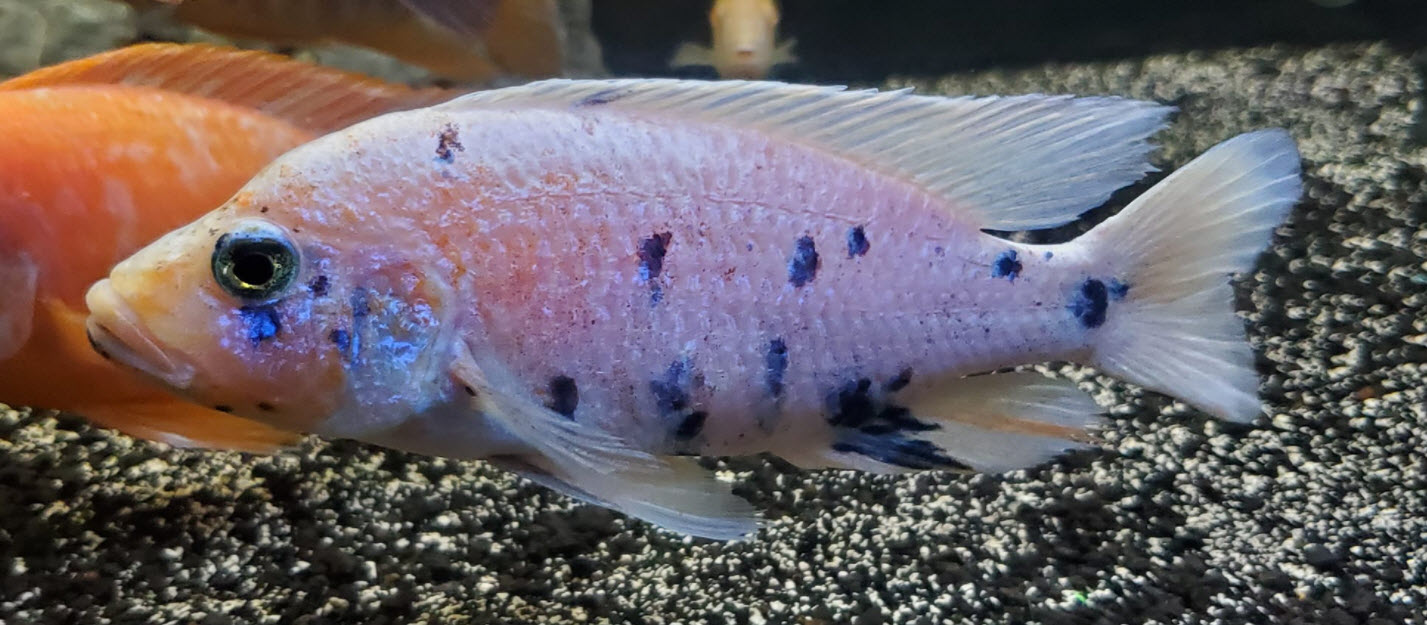
The calculated concentrations where 95% of the fish live long and healthy lives (LC95 years) is easily calculated from the “LC50 days” data. And this figure is much higher than these two papers conclude. The New Zealand paper even has in it the LC50 data from three papers reviewed where the LC50 of the fish was in the 1,000 ppm range. An LC50 of 1,000 will result in a calculated long term 5% lethal concentration of about 600 ppm per the API test of nitrate, quite a bit higher than these papers recommend as limits.
Another obvious problem is than nitrate is much like alcohol. The liver of the fish becomes much better at handling nitrate as time goes on. So all the studies where fish were put into aquariums or tanks where the IMMEDIATE concentration of nitrate was something like 1,000 have a rather obvious problem. I found no studies where the nitrate levels were gradually increased with time.
Still a third obvious problem with these studies is their “controls”. The “controls” in these studies were where there were zero additions of a nitrate salt such as potassium nitrate. The “controls” should have been where equal concentrations of potassium chloride were added to the water. If one doesn’t do this one might be seeing a “noticeable effect” from potassium, not nitrate. I found no studies which did this with their controls.
And a fourth problem is that the referenced studies used potassium nitrate. Per “Environment Canada 2003”, potassium nitrate is five to eight times more toxic than sodium nitrate. Most of the nitrate in most aquariums will be sodium nitrate. So using potassium nitrate as the nitrate salt can give misleading data.
But the environmentalists will simply ignore these four problems and continue to claim nitrate at ANY level is a horrible thing to have in any waterway. The problem for us in the aquarium hobby is when some unsuspecting but sincere hobbyists comes across these studies and come to unwarranted conclusions about the safe levels of nitrate in the aquarium.

Lowest Toxicity Studies on Nitrate
The toxicity levels observed for tropical fish in five studies averaged an LC50 96 hour level of 222 N-NO3 (scientists test) or 979 ppm NO3 (API nitrate test kit) for guppy fry. This data on five tropical fish studies was then used by the author as the basis for extrapolating the long-term effects of nitrate on fish using the well established toxicity model, the Reduced Life Expectancy (RLE) model.
This is the result of using this model on life expectancy versus nitrate levels (API test).
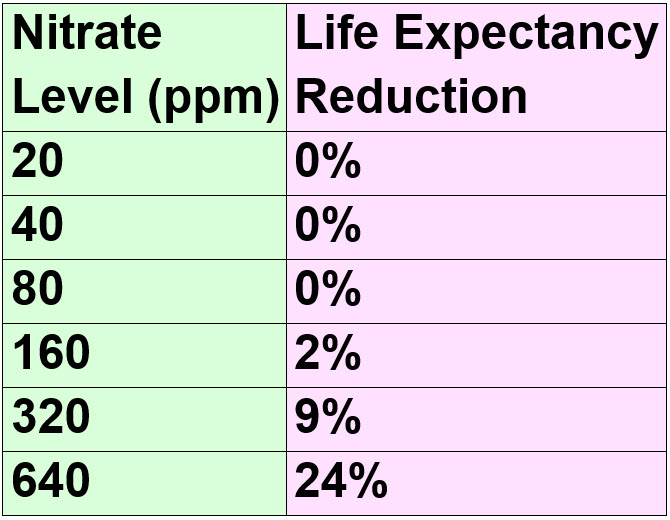
It must be emphasized this is for only aquarium fish and it applies to the lifespan of the fish, not ninety days or such. This is a VERY LOW TOXICITY. And the data is for aquarium fish, not aquaculture fish.
But this is still VERY SUBJECTIVE. Some hobbyists will not want even 1% impact on the life of their fish. Others will be just fine with it. To each their own. If you want to change 50% of your tank water every three days, have at it!

What is a Reasonable Nitrate level for an Aquarium?
Note that those with mixed fish/planted aquariums routinely keep the nitrates at 40 to 80 ppm to keep the plants well fertilized and growing. There is no apparent problem with the fish in such an arrangement. And many people including the author have bred fish in water with 80 ppm nitrates quite successfully.
Based on this rather exhaustive search of scientific journal articles, the following are the upper toxic limits on nitrate for freshwater fish:
- Chronic: 440 to 1200 ppm depending on species
- Acute: 880 to 4,400 ppm depending on species
Now this is “limits”. At levels below these levels there will be some impact on a fish health but the significance of this impact is a matter for endless debate in social media. I’ll leave that to whatever each hobbyist is comfortable with.
Of course, there have to be modifiers to these levels. Bacteria count in the water column typically rises in lock step with the nitrate level. And bacteria count is important. Also phosphate rises with nitrate rising and the two together can give massive algae break outs. Massive algae outbreaks can reduce the oxygen level in the water column. And low oxygen levels are a known contributor to poor fish health.
The level of nitrate one wants to hold determines the frequency of the water changes. The lower the nitrate level the more one has to change the water. And the more one has to change the water the more likely it is that one will give up the hobby in a short period of time.

Now this is a very gray area. Will 40 ppm impact health significantly? Will 80 ppm impact health significantly? Will 160 ppm impact health significantly? It all just depends on your definition of “significant”.
With the popular API test kit for nitrate it is very difficult to find any difference between 40 and 80 ppm nitrate. Aiming towards a “orange-red” but not “red red” on the API test is a very reasonable course for most hobbyists.
Those well meaning but ill-informed commentators on social media who say anything over 20 is toxic and detrimental to fish are simply wrong (one commentator said anything over 10 ppm. will shorten the life of the fish). This level simply cannot be supported in the journal literature, for any reason. The amount of water changes need to maintain such low levels will drive people out of the hobby.
And there are some people who have tap water which is over 40 ppm in nitrates. There is no reason to panic if that is the case. In all probability all adult fish will be just fine in such water.
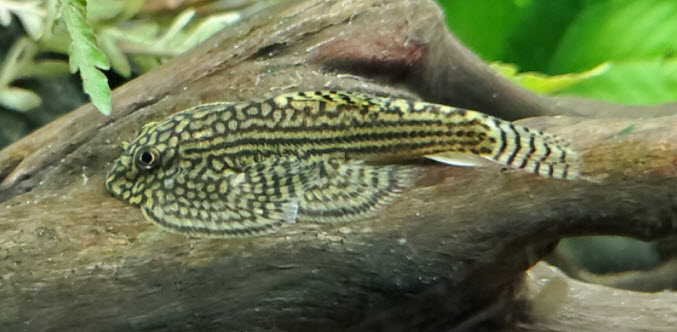
The “Profit” Problem
There are a host of charts and websites which say one should do a 50% water change if you have 20 ppm of nitrate (i.e. a level of 10 ppm or less must be maintained) in order to have healthy fish. This typically translates into a 50% water change once a week. Some simple calculations say that the market for aquarium water conditioners is about $150 million if hobbyists do 50% water changes once a week.
If hobbyists only change the water when the nitrate level goes to 80 ppm (i.e. a level of 40 should be maintained, a far more realistic number) then the yearly market for conditioners is only $37 million. So that basically is 113 million reasons for the charts and the recommendations. Isn’t the profit motive great?
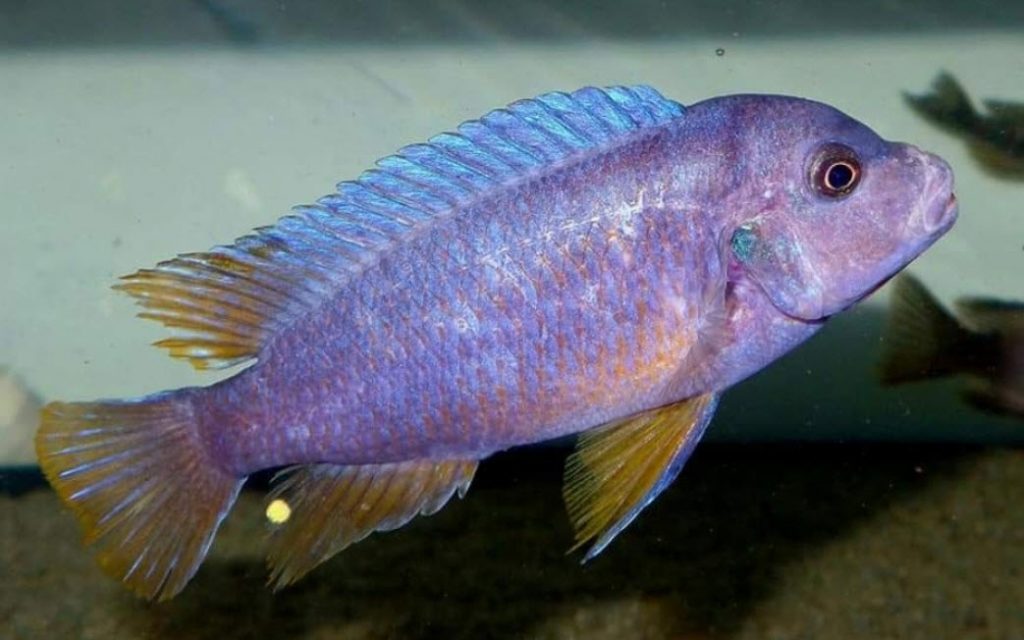
Note that this whole article has one big problem. Namely that it is impossible to prove a negative. No matter how many papers I can come up with there will always be those who say “what about this or that set of circumstances, no papers cover that“. Thus the verbosity.

Return to Water Parameters Menu
.
Aquarium Science Website
The chapters shown below or on the right side in maroon lead to close to 400 articles on all aspects of keeping a freshwater aquarium. These articles have NO links to profit making sites and are thus unbiased in their recommendations, unlike all the for-profit sites you will find with Google. Bookmark and browse!
.

Dave says
In reply to Michael …. People believe myths. And the more times they hear the myth the more they believe it.
Michael Crabb says
Thank you. 40 to 80 ppm seems much more reasonable. I totally agree that $$ drives the lower numbers. Why are so many so adiment about the 20ppm?